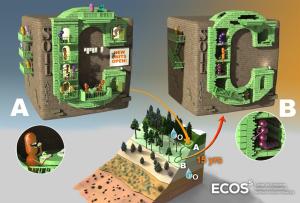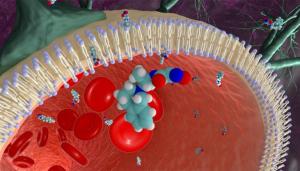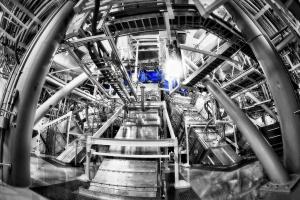LAB REPORT
Science and Technology Making Headlines
Oct. 22, 2021


A simulation suggesting the effects of a 1 megaton nuclear blast on an asteroid approximately 300 feet in size. Animation by King et al.
Saving Earth from a stealthy asteroid
One day, astronomers may spot an asteroid months away from a cataclysmic rendezvous with Earth. Our only chance of survival at such a late stage would be to try to use a nuclear explosive to obliterate it.
But would it work?
Unlike some melodramatic Hollywood blockbusters of the 1990s, real-life scientists are largely unconcerned by any planet-sterilizing behemoths. The orbits of almost every asteroid two-thirds of a mile across or larger have been precisely mapped out. “We know they’re not going to be a threat anytime soon,” said Megan Bruck Syal, a planetary defense researcher at the Lawrence Livermore National Laboratory.
Instead, their focus is on relatively small asteroids, those about the size of football stadiums, notable for their abundance as well as their ability to evade asteroid-hunting observatories. “Those are the ones that we tend to worry more about because they could come out of nowhere,” Bruck Syal said.
Such a diminutive asteroid may not sound like much of a danger compared to the 6.2-mile colossus that slammed into Earth 66 million years ago with apocalyptic results. But a meteor that exploded over Siberia back in 1908 was only about 200 feet across — and the blast’s shock wave leveled 800 square miles of forest. “That’s the size of the whole Washington D.C. metro area,” said Bruck Syal.


In a warming world, microbes grow slower, and a loss of soil carbon may be the reason for the slow down. Graphic courtesy of Victor O. Leshyk, Ecoss
Microbes in the hot seat
In a first-of-its-kind warming experiment, researchers at Lawrence Livermore and Northern Arizona University found that microbes growth rate decreased over 15 years of warming. The research showed that under warmer climate conditions, growth decreased among all types of microbes in the community, and suggested that a loss of soil carbon may be responsible for the
To investigate the effect of warming on microbial communities, the team transplanted cylinders of soil from high-elevation forests north of Flagstaff to lower, warmer meadows to simulate climate warming, transplanting others at the highest elevation as controls. Over 15 years, the lower-elevation transplants were watered to match higher precipitation of their original climate, and researchers removed samples of the soil at regular intervals. Using quantitative stable isotope probing, or qSIP, the research team used water “labeled” with enriched oxygen to see which microbes incorporated the element into their DNA — a sign of growth.
These results offer an interesting counterpoint to short-term, laboratory-based warming experiments, which have shown that the growth of many microbes spikes under warmer conditions.

LLNL-02 can pass through the blood-brain barrier (pictured), making it more effective in protecting the central nervous system. Image by Liam Krauss/LLNL.
Hitting a nerve
Nerve agent poisoning can result in a quick death, causing the central and peripheral nervous systems to shut down. For those fortunate enough to receive medical care and survive exposure, long-lasting side effects are probable, including seizures, extreme muscle spasms and diminished mental functioning.
Scientists from Lawrence Livermore National Laboratory (LLNL) are developing a new antidote that substantially counteracts the exposure of nerve agent poisoning. The antidote, labeled LLNL-02, was first identified by the researchers in 2017 after two years of experimentation, including 120 attempts to design compounds before finding a winning candidate. In subsequent years, the scientists achieved two milestones with LLNL-02: the compound crossed the blood-brain barrier, and it attacked the parts of the brain hijacked by the nerve agent sarin. The researchers described it like finding a needle in a haystack.
“It’s like you have to find a compound that not only was able to cross the blood-brain barrier, but it also needed to reactivate the enzyme,” said Carlos A. Valdez, LLNL lead chemist of the project.
That “enzyme,” acetylcholinesterase (AChE), is a key player in neurotransmission. When a nerve agent enters the body, it attaches itself to AChE, disrupting the enzyme’s ability to break down the neurotransmitter acetylcholine. This results in the buildup of the chemical acetylcholine in the brain. The accumulation causes organs to fail, and exposure becomes lethal when the muscles involved in respiration cease to work. LLNL-02 reverses that process.


To address porosity and defects in metal 3D printing, LLNL researchers experimented with exotic optical laser beam shapes known as Bessel beams and discovered the beams had unique properties such as self-healing and non-diffraction and reduced the likelihood of pore formation and “keyholing,” a porosity-inducing phenomenon exacerbated by the use of Gaussian beams. Image by Veronica Chen/LLNL
Beam me up
Lawrence Livermore scientists are exploring beam shaping to improve metal additive manufacturing.
The team has been working to address issues such as defects and poor mechanical performance that can arise during laser-based Additive Manufacturing (AM) techniques for metal parts. The researchers have explored alternative shapes to the Gaussian beams commonly used in high-power laser-based AM processes such as Laser Beam Powder Bed Fusion (PBF-LB).
In a recent report, the researchers experimented with exotic optical beam shapes known as Bessel beams — reminiscent of bullseye patterns — which possess a number of unique properties such as self-healing and non-diffraction. They discovered that the application of these types of beams reduced the likelihood of pore formation and ‘keyholing.’
LLNL researchers explained that the work indicates that alternative shapes such as Bessel beams could alleviate the main concerns in the PBF-LB technique: the large thermal gradient and complex melt pool instabilities occurring where the laser meets the metal powder. The issues are reported to be predominantly caused by Gaussian beam shapes that most off-the-shelf, high-power laser systems typically output.


This image of NIF beamlines entering the lower hemisphere of he NIF target chamber. LLNL ressearchers hit a huge milestone in the search for fusion.
In search of
A breakthrough experiment this summer at Lawrence Livermore National Laboratory's (LLNL) National Ignition Facility (NIF) has turned up a whopping 1.3 megajoules of energy, or about three percent of the energy contained in one kilogram of crude oil. The work, puts physicists "at the threshold of fusion ignition," according to the Lab.
Nuclear fusion, in the simplest terms, is a reaction in which atoms are smashed together to generate an abundance of energy. In some ways, it's less dangerous than nuclear fission — a process that involves splitting heavy, unstable atoms into two lighter ones — and has the potential to create a lot more energy.
All of today's functional nuclear power plants currently use nuclear fission, and scientists have long been on the hunt for a way to make nuclear fusion a reality; consider it a kind of holy grail of clean energy.





